Kathy Lynn Emerson's Blog, page 97
August 27, 2015
Judge Dread
Psst. Down here. It’s me, Chris. You might be wondering why I’m hiding under my desk with a pitcher of Mylanta White Russians. Well, I’ll tell you.
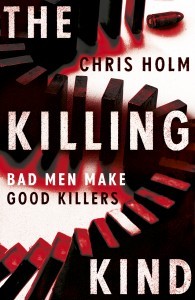
My, but that UK cover’s snazzy.
As of yesterday, THE KILLING KIND is officially out in the world. Okay, part of the world. More specifically, the British part. It doesn’t come out in the US for another couple weeks. (September 15th, to be exact. Which means you still have plenty of time to preorder it if you’d like.)
Book releases are wonderful, stressful, terrifying experiences. It’s like hosting an open house in your own head. “Greetings, strangers!” you say. “Here’s all the weird stuff I’ve been secretly thinking about for the past few years. Come poke around and then judge me on the internet.” And believe you me, they will.
I’ve been fortunate in my career. Most of my reviews have been quite favorable. So far, THE KILLING KIND has extended that streak. It received a starred review from Kirkus, as well as very favorable reviews from from Library Journal and Publishers Weekly. But, like all authors, my books have gotten their share of howlers, too, and I’m sure I’ll get plenty more before I’m through. There’s no point complaining; it comes with the gig. You’ve just got to find a way to come to grips with it.
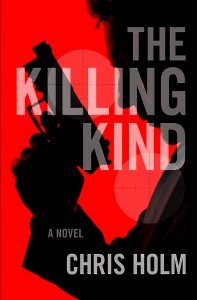
This is what the US version looks like. Commit it to memory. Consider memorializing it in tattoo form. Did I mention there’s still time to preorder?
I used to Google obsessively as release day approached, and read every single review I got. I even had a tried-and-true method for putting bad ones behind me. Thankfully, I’ve since mellowed. Sure, I’ll read the first couple reviews on Amazon and Goodreads, just to see which way the wind is blowing, but after that, I’ll glance occasionally at my average, and that’s that. If a book blogger points me toward their review on Twitter, I’ll read it, but I no longer seek them out. (Side note, bloggers: don’t feel obligated to @ message an author if you’ve given them a poor review. Most writers, this one included, would rather wallow in blissful ignorance.) And while I’ll cop to reading every professional review I get, these days it’s with an eagle eye and a mercenary heart, always looking for a pull quote I can use.
That’s not to say I don’t care what people think of my books. I care deeply. Too much, in fact. All authors do. But we live in a time when anyone can judge anything for any reason. It doesn’t pay to take it all to heart.
But why take my word for it, when you can hear from actual famous people instead?
August 26, 2015
Stuck? Busy? Unproductive? Some Thoughts About Finishing Your Work
 Kate Flora: Something happens to a lot of us as September approaches. Conditioned by anywhere from 12 – 19 years of going back to class each fall, we start thinking about getting serious about our work. Knuckling down to postponed projects. Finally writing that story or novel. Below are some thoughts from a handout I give my students at the end of a six-week writing class:
Kate Flora: Something happens to a lot of us as September approaches. Conditioned by anywhere from 12 – 19 years of going back to class each fall, we start thinking about getting serious about our work. Knuckling down to postponed projects. Finally writing that story or novel. Below are some thoughts from a handout I give my students at the end of a six-week writing class:
Write something you would like to read
Always remember that the enemy is not the badly written page but the empty page.
Think Anne Lamott, Bird by Bird, and the shitty first draft.
Those Pesky Editing Heads
You know the ones, they keep giving advice, and criticism, and fuss and fidget about every sentence you write until your head spins and you can’t write a word? Think about turning off the editing heads long enough to let you get something down on the page that you can work with.
sentence you write until your head spins and you can’t write a word? Think about turning off the editing heads long enough to let you get something down on the page that you can work with.
Consider doing NaNoWriMo (National Novel Writers Month) in November, where the word count forces you to write with obsessing. Remind yourself that getting it down is more important than getting it right. You can use rewrite to make corrections and improvements.
Remember that perfection is not possible.
Show, don’t tell and other things we’re told that are true
Or, as one of my students once said to another: I now know how I’m supposed to feel, what I want you to do is make me feel it.
Specific is better than general. Details make a scene feel authentic. Remember that as long as you avoid the “data dump” readers love lore.
Be true to your ideas and your characters, not your story. Don’t bend your characters to fit the story, bend the story to fit who your characters are. Let the actions and the conflicts arise from who they are.
Treat your reader honestly. Don’t hold back a lot of secrets. You can mislead, using the shell game of clues and action, or an unreliable narrator, but don’t lie.
Remember, when you’re in a snarling, sweaty lather, that this is supposed to be fun. It’s only a book.
Where Do You Write?
Are you honoring your passion for writing by creating a good place to work? Remember that no one will make your writing time for you, and others won’t respect your desire to write if you don’t.
 Dedicated place – remember that sometimes having a particular place where you write can become a part of the writing process.
Dedicated place – remember that sometimes having a particular place where you write can become a part of the writing process.
Rituals: Going there, sitting down, opening a notebook or a file, all of these ordinary actions can become a form of ritual which may help you get back into what you are writing. Many writers also have the practice of rereading and editing what they wrote in the last session to start the writing flow.
What’s around you: Consider whether there are things you can do to make it more appealing or inspiring—a bulletin board with notes to yourself, or pictures which relate to what you are writing or something you want to write. A quote that raises a question. A quote that uses the language you would like to use. Something someone has written or said that inspires you or challenges you.Conversely, you might post a picture of Kanye West, who brags that he doesn’t read. Sometimes an “I’ll show you” attitude can also help to get going.
Dedicated time:
My writing teacher used to say that any writing session should be at least two hours—the first hour to shed the world and focus the mind and the second hour to really get down to the writing. Only you will know what works best for you, but trying to build in a few sessions of dedicated time is important. Don’t have two hours? Don’t worry. A regular practice is what is most important. Check out Stephen P. Kelner’s book, Motivate Your Writing and Kenneth Atchity’s book, A Writer’s Time.
Work with a set of realistic goals.
Do set deadlines but be sure that they fit with what you know about your writing style and  how much time you have. If, for example, you can set a goal of five pages a week, in a year, you’ll have novel. In a month, you could have a twenty page short story. Setting a word count or page count gives you a positive feeling of accomplishment as those pages pile up. It also helps to still those pesky editing heads. You can tell them you’ll get back to them just as soon as you reach your goal. With luck, the words will flow and you’ll write more than five pages.
how much time you have. If, for example, you can set a goal of five pages a week, in a year, you’ll have novel. In a month, you could have a twenty page short story. Setting a word count or page count gives you a positive feeling of accomplishment as those pages pile up. It also helps to still those pesky editing heads. You can tell them you’ll get back to them just as soon as you reach your goal. With luck, the words will flow and you’ll write more than five pages.
Save Everything – even when it feels like you’re writing gravel or the story takes an unplanned turn. Another time, you may want to recycle what you wrote there. Or you may reread the pages at a future date and decide, with a bit of editing, that they aren’t so bad.
Write You Are Meant to Write:
Be sure that your material is something you care about. You need to:
Care about the personality of your characters;
Care about the themes of your story;
Care about what’s at stake
Because if it doesn’t matter to you, it won’t matter to your reader.
Some thoughts about breaking the log jam:
Make a calendar/spreadsheet/whatever and chart each scene: time of day, characters, what happens. Try to plot out the next five to ten scenes. Sometimes working scene by scene can be less overwhelming than chapter by chapter or than trying to envision the whole story.
Consider learning about how to use a storyboard with yellow stickies you can move around to rearrange scenes and chapters
Some writers use Scrivener to organize their writing.
Print out and read the book or story straight through until now. Reading hard copy can give it a different feel.
To get a sense of the rhythm of your writing, read it into a recorder or your phone and then play it back. Read it to someone else. Have someone read it to you.
Stuck and thinking you’re unable to go forward? Write a scene you know you will use later on.
Teeing off the above, if you don’t know how to get from Chapter One or Page One to The End, write the scenes you do know and then think about what you’ll need to write to connect them. Then start writing those connections. There is no one “right” way to write your story. There is only your way.
Write the ending, then go back to where you got stuck and write toward it.
Apply butt to chair. Remain until 500 words are down. Repeat at your next writing session. Even if it’s crap, a synergistic “something” will often happen that will show you the path. Remember those first painful trips to the gym when you’ve been delinquent? Your writing muscles will get stronger.
Go back to the first chapter and read through what you’ve already written, editing as you go. It helps to find the momentum again, and to continue on. Pay attention to your character. Did you get off track? Is your character not acting like him or herself? Is anything happening that matters? Have you gotten stuck because your own story is boring you? Shake things up. Let your character do something unexpected.
Sometimes pulling something out and wrestling with it can make it start to work. Practice the type of “riff writing” Elizabeth Lyon describes in her excellent book on revision, Manuscript Makeover.
If your character is still misbehaving, take him or her for that ride in the car and ask why the character is behaving in that way. Seriously. The first time I heard writers say this, I thought it was crazy, but you need to be writing characters you want to spend time with. Characters, just like employees, can be fired if they’re not doing their job.
Still stuck?
Remind yourself that brain surgeons don’t often complain about surgeon’s block, and pilots have to keep flying the planes. Remember that just because it’s hard doesn’t mean you give up. Most things that are worth doing are hard. So if you’ve written your 500 words for days and are still getting gravel, take out your trusty copy of Anne Bernays and Pamela Painter’s What If? and do some exercises.
Take yourself on an artist’s date and see if refilling the well might help. The world is full of fascinating things that may get you writing again.
…An artist date is a block of time, perhaps two hours weekly, especially set aside and committed to nurturing your creative consciousness, your inner artist. In its most primary form, the artist date is an excursion, a play date that you preplan and defend against all interlopers. You do not take anyone on this artist date but you and your inner artist, a.k.a your creative child…
Excerpt from The Artist’s Way, page 18 Julia Cameron
When all else fails, try ironing. Smoothing things out and creating order may either inspire you or the repetitive tedium may send you gratefully back to the keyboard.
August 25, 2015
Murder without the Gore: Part II
Kathy Lynn Emerson/Kaitlyn Dunnett here, continuing my discussion of traditional mysteries, particularly those labeled cozies. To read part one, click here
I’ve seen a lot of discussion about likeable and unlikeable characters. The sleuth, it’s said, should be likeable, as should her friends. The victim and the villain . . . not so much. A great many of the victims in cozies seem to deserve their fates, but there is no rule that says they have to be unlikeable. I killed off a woman everyone in town loved in the first book in my series, Kilt Dead . . . on the advice of my agent. By the same token, some of my continuing characters are obnoxious. That could mean they’ll end up being victims in later books . . . or not. If I were to kill off everyone who’s annoying, I could end up with a bunch of very dull characters!
 Personally, I don’t believe the sleuth always has to be likeable either. In the case of Liss MacCrimmon, some readers find her fresh and interesting while she annoys the hell out of others. In my current historical series, the sleuth is someone I spun off from the earlier Face Down series. She was a child in those, a spoiled brat with rather despicable parents. Frankly, I think her flaws make her more interesting, as well as giving her room to grow and mature. I toned her down a bit on the advice of my agent, but she’s still got some bite. My publisher loves her—which frankly is all that really matters—and although a few reviews have indicated that readers find her annoying, most seem to have had a positive reaction to her unique situation and personality.
Personally, I don’t believe the sleuth always has to be likeable either. In the case of Liss MacCrimmon, some readers find her fresh and interesting while she annoys the hell out of others. In my current historical series, the sleuth is someone I spun off from the earlier Face Down series. She was a child in those, a spoiled brat with rather despicable parents. Frankly, I think her flaws make her more interesting, as well as giving her room to grow and mature. I toned her down a bit on the advice of my agent, but she’s still got some bite. My publisher loves her—which frankly is all that really matters—and although a few reviews have indicated that readers find her annoying, most seem to have had a positive reaction to her unique situation and personality.
And with that, let me segue into the historical mystery subgenre. Historical mysteries are not always traditional mysteries, but they certainly can be. It depends on the level of sex and violence. Historical, at least in the definition used by the Bruce Alexander and Agatha awards, refers to mysteries that take place prior to 1950. Novels that were contemporary when they were written, such as those by Agatha Christie or Dorothy L. Sayers, are not historical novels.
 Another type of traditional mystery is the humorous mystery, which includes the caper. In these, humor is the most prominent feature. Examples are the Stephanie Plum novels by Janet Evanovich, Joan Hess’s Maggody series, Dorothy Cannell’s Ellie Haskell series and, of course, all four series written by the late, great Maine writer, Charlotte MacLeod.
Another type of traditional mystery is the humorous mystery, which includes the caper. In these, humor is the most prominent feature. Examples are the Stephanie Plum novels by Janet Evanovich, Joan Hess’s Maggody series, Dorothy Cannell’s Ellie Haskell series and, of course, all four series written by the late, great Maine writer, Charlotte MacLeod.
One caveat if you are going to attempt to be funny: humor is always tricky because it is so subjective. What one person finds hilarious may strike another as just plain stupid. Worse, readers who miss the point of something that is meant to be funny quite often get snarky about it when they post a review.
You’ll sometimes hear the criticism TSTL leveled at the heroine of a novel. Too stupid to live. It’s best personified by the Gothic heroine who, in the middle of the night in her flowing white nightgown with only a candle for light, goes down in the basement, or up in the attic, or out into the night, because she hears a strange sound. I decided to have a little fun with this in one of the Liss MacCrimmon books by turning it into a running gag. Liss finds this trait annoying when she comes across it in a book and when others do stupid things, and then, of course, ends up doing something equally stupid herself. Most readers seem to have caught on to the joke but one reader, one who, naturally, posted a review on Amazon, got so mad at Liss that she quit reading before she got to the punch line.
Sometimes you just can’t win.
What’s funny . . . and what isn’t . . . is in the mind of the reader.
 Another subgenre of the traditional mystery is romantic suspense, although you’re as likely to find these books shelved in the romance section of the bookstore as in the mystery aisle. Classic romantic suspense written by people like Daphne du Maurier, Mary Stewart, Phyllis A. Whitney, and Barbara Michaels have always been considered traditional mysteries, too. What’s being written today tends to include romantic encounters that are a little more explicit than some fans of the traditional mystery want to read, and offer plots that are about a 50/50 split between the romance and the suspense, but if you skip over the more graphic sex scenes, writers like Nora Roberts and Jayne Ann Krentz, to name just two prominent, bestselling authors, fit quite easily into the traditional mystery genre.
Another subgenre of the traditional mystery is romantic suspense, although you’re as likely to find these books shelved in the romance section of the bookstore as in the mystery aisle. Classic romantic suspense written by people like Daphne du Maurier, Mary Stewart, Phyllis A. Whitney, and Barbara Michaels have always been considered traditional mysteries, too. What’s being written today tends to include romantic encounters that are a little more explicit than some fans of the traditional mystery want to read, and offer plots that are about a 50/50 split between the romance and the suspense, but if you skip over the more graphic sex scenes, writers like Nora Roberts and Jayne Ann Krentz, to name just two prominent, bestselling authors, fit quite easily into the traditional mystery genre.
 When you stop and think about it, most mysteries nowadays contain some elements of romance. Although there are readers who avoid reading series that burden the sleuth with a love interest, convincing relationships between the detective and those close to him or her—family and friends as well as lovers—are what turn a character from a cardboard cutout into a human being. Some of the best mysteries, past and present, include romance. Even series where the detective is celibate, such as Ellis Peters’s Cadfael, contain subplots where a pair (or two) of young lovers complicate the case.
When you stop and think about it, most mysteries nowadays contain some elements of romance. Although there are readers who avoid reading series that burden the sleuth with a love interest, convincing relationships between the detective and those close to him or her—family and friends as well as lovers—are what turn a character from a cardboard cutout into a human being. Some of the best mysteries, past and present, include romance. Even series where the detective is celibate, such as Ellis Peters’s Cadfael, contain subplots where a pair (or two) of young lovers complicate the case.
Most traditional mystery novels weave together the mystery plot (the sleuth discovering who dunnit) with one, and sometimes two, subplots. Usually, the main subplot involves an aspect of the sleuth’s private life. It could be a romantic dilemma, conflict with another character, or a secondary mystery that needs solving. Whatever it is, it adds depth to the novel and aids in character development. Ideally, the plot and subplot are inseparable.
“Murder without the Gore: Part III” will be posted next month on September 8. In the meantime, feel free to chime in with opinions, reading suggestions, and general comments on the subject. Happy Reading.
Kathy Lynn Emerson/Kaitlyn Dunnett is the author of over fifty books written under several names. She won the Agatha Award in 2008 for best mystery nonfiction for How to Write Killer Historical Mysteries and was an Agatha Award finalist in 2014 in the best mystery short story category for “The Blessing Witch.” Currently she writes the contemporary Liss MacCrimmon Mysteries (The Scottie Barked at Midnight) as Kaitlyn and the historical Mistress Jaffrey Mysteries as Kathy (Murder in the Merchant’s Hall). The latter series is a spin-off from her earlier “Face Down” series and is set in Elizabethan England. Her websites are www.KaitlynDunnett.com and www.KathyLynnEmerson.com
Welcome Jessie Crockett
Hi. Barb here. Today, Jessie Crockett will be joining the Maine Crime Writers for the first time. I originally met Jessie through Sisters in Crime New England. Our first books came out at the same time in August, 2010 and we’ve been connected ever since. I blog with Jessie over at Wicked Cozy Authors, so I know a few of her secrets. We thought it would be fun if I interviewed her as a way of introducing Jessie to all of you.
BR: Welcome to Maine Crime Writers, Jessie!
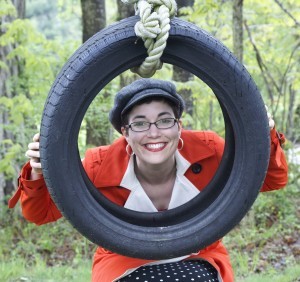 JC: Thanks so much of having me! I love to spend time in Maine either in the real world or the cyber one!
JC: Thanks so much of having me! I love to spend time in Maine either in the real world or the cyber one!
BR: You live in New Hampshire most of the year and your current connection to Maine is your summer residence in Old Orchard Beach, but I know you have deep roots in Maine going back on both sides of your family. Tell us about them.
JC: Both of my parents were from Maine and all the people in their families going back time out of mind. My father’s people were from the East Dixfield area and my mother’s were from mid-coast. I have family with birthplaces from Carthage Basin to Vinal Haven and all sorts of spots in between.
BR: Your first two series are set in New Hampshire. Tell us a little about Live Free or Die and the Sugar Grove series.
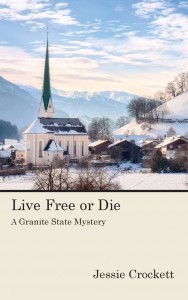 JC: New Hampshire, like Maine is filled with interesting architecture, natural beauty and self-reliant citizens. Both my Granite State mystery series and the Sugar Grove series celebrate all those things. In Live Free or Die the protagonist is the chief of her volunteer fire department and the solution to the mysteries she is facing can be found in the past as much as the present. The Sugar Grove books look at life on a family tree farm and what it means to carve out a unique niche in a large family.
JC: New Hampshire, like Maine is filled with interesting architecture, natural beauty and self-reliant citizens. Both my Granite State mystery series and the Sugar Grove series celebrate all those things. In Live Free or Die the protagonist is the chief of her volunteer fire department and the solution to the mysteries she is facing can be found in the past as much as the present. The Sugar Grove books look at life on a family tree farm and what it means to carve out a unique niche in a large family.
BR: You are currently working on a new historical series for Berkley set in Old Orchard Beach in 1898. What about Old Orchard Beach inspires you?
JC: Just about everything! I love the beach, of course and the miles of sand to walk and think. Just doing that primes the creative pump for me. But even more is the extraordinary history of the place. The series I am writing takes place the year the pier opens for the first time. At the time it was built it was the world’s longest pleasure pier and as such, a tremendous attraction. Trains deposited thousands of vacationers every day all summer long. The variety of people it attracted is astonishing. There are the famous like Louis Armstrong and Charles Lindberg. There were wealthy families who stayed for the season in grand hotels and mill girls who came for a day at the seaside. It was actually difficult for me to choose a time period to focus on because so many decades were so appealing.
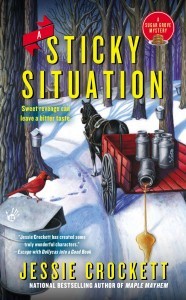 BR:When you are in Maine, where do you write? What are you looking at as you work?
BR:When you are in Maine, where do you write? What are you looking at as you work?
JC: I work on the front porch. My desk faces the street but the screen door allows in breezes from the sea. The sounds of crashing waves and squeals from amusement park riders run uphill and spill all over me as I write. In spring and fall, when the leaves are off the trees, I can catch a glimpse of the water winking up at me. Truly, I am blessed.
BR: Recommend a favorite spot in Maine. A “hidden gem” if you will.
JC: This may not be what you had in mind but I’m going to say Heavenly Socks in Belfast. It is a yarn shop with an unusual amount of sock-weight yarn on offer. The staff is knowledgeable and so welcoming. And the town is charming. Well worth the drive.
BR: I think that’s a great recommendation. I’ll have to tell my sister-in-law who runs a yarn shop about it.
Everyone, say hello to Jessie!
August 24, 2015
Previous blog
Kathy Lynn Emerson
Stiffing Clyde
“Ayup, scared the poor booger half to death. it’s bad enough the kid has to freeze his butt delivering papers with the wind chill at minus 40, but to come upon Clyde like that. I’d be surprised if he ever delivers another newspaper.” I knew I was having trouble being heard. Between the whirling emotions coursing through me and the keening of a bitter Sunday morning wind outside, it wasn’t easy. I said goodbye to my cousin Phil and willed my shaking hand to set the phone back in its cradle.
I watched crime scene tape slapping in the fierce wind out by my mailbox as I drank a third cup of badly brewed coffee and remembered the scene a scant three hours earlier. The paperboy had come upon my best friend Clyde Randall leaning against the post, clad in a tattered sweatshirt and equally tattered jeans, holding a half empty bottle of Old Rose whiskey. Both he and the contents of the bottle were frozen solid. I had wondered briefly why Clyde had been out in such weather dressed like that, before giving in to a monumental sense of loss as I dialed 911.
The sheriff’s deputy and the medical examiner had borrowed a kettle of hot water to help free Clyde’s body from the iron box that was holding it in an unforgiving grip. Neither had attempted to do the same with the bottle clutched by his solidly frozen left hand. Somehow that seemed perfectly appropriate in a bizarre way. Later today, after I had finished recovering from the shock and had gone through my own private grief, I’d have to brave the elements and make a formal identification at the county courthouse. I knew I’d also have to make funeral arrangements but I wasn’t up to it at the moment.
I filled the pellet stove and stared out the living room window as I heard the familiar uptake of the auger followed by the whine of the blower motor, forcing frigid air through the newly deposited pellets. The burst of warm air behind me was a small, but welcome comfort as I watched snow devils chase each other across the icy surface at the foot of the hill. Clyde and I had pretty much lived on and in Simonton Pond when we were growing up. With his father long gone and his mother having to work two jobs in order to support three kids, Clyde was informally adopted by my parents, even to having his own room next to mine upstairs in this house.
We had done everything together, hunting, fishing, stealing apples from the neighboring orchard, even double-dated through high school. Clyde hadn’t been a very good student and when we graduated back in 1969, I went to college and he got a job as a welder’s apprentice at Bath Iron Works. He had a natural aptitude for working with metal and completed the training program two months ahead of schedule. That, coupled with an engagement to a girl from East Prospect, had his future looking really bright while I struggled with classes of 200 and a deceptively inviting social scene. By Christmas time, we were headed in different directions; Clyde was headed down rose lane, while I was on the thin edge of flunking out and disappointing my parents.
How quickly things can change when you least expect them. By Valentine’s Day, I was maintaining a B average and had escaped the party scene while Clyde had been drafted over protests by Bath Iron Works management that he was essential to the war effort as a welder. He thought briefly about joining the coast guard, but his hesitation cost him as the quota for the month filled up in a heartbeat. By April Fools Day, he was in Texas halfway through basic training.
The summer of 1970 was gloomy in more ways than one. I was working as a bridge painter, but fog and rain limited us to three days or less per week. News from Clyde matched the weather. Despite his welding skills, the army had sent him to infantry school and he would be shipping to Vietnam shortly after Labor Day. Matters were compounded when his wife to be got cold feet and broke the engagement long distance. I didn’t hear from Clyde for almost four months. As his tour crept toward an end, his letters became shorter and bleaker. He kept referring to events that he said were beyond belief or description and had him seeking refuge in whatever the mind numbing substance of the day happened to be. I felt completely helpless and even a bit guilty because my life at the university was really good.
After he was discharged, Clyde didn’t come back to Maine right away. BIW was required to keep his job open for six months and he said he needed time away from home to see if he could exorcise the devils who had taken up residence in his head. He was living in a commune outside of Sacramento, California.
I barely recognized the animated skeleton who knocked on my door one night in October. Clyde looked like Charlie Manson with Jesus eyes. He was shaky and wouldn’t look at me. I let him smoke a couple joints on the back porch while I wondered if I was in any position to help him. Quite honestly, I wasn’t sure and that hurt a lot.
Over the next six hours, he rambled, sometimes incoherently sometimes with frightening clarity, about things he had seen and things he thought he should have prevented from happening in remote Vietnamese villages. His mental body count was horrifying. I did my best to reassure him that it wasn’t his fault, but I might as well been trying to reverse the flow of a glacier.
After a stay at the V.A. hospital, Clyde started attending AA meetings and went back to work as a welder. Neither effort was successful. Almost every time sparks started flying when he welded, Clyde flashed back to nighttime scenes of tracer bullets ripping through villages and body parts would fly at him from all directions. He couldn’t take it without some form of emotional anesthesia and failed three drug tests. The iron works did everything they could to help him, trying Clyde in several different jobs, but the internal damage was too severe. He was let go while on another stint at the V.A. hospital.
The army, always a good enabler, assessed his combat-related disability at 80%, ensuring that he wouldn’t have to work, but still have enough income to feed his addiction. Clyde supplemented the pension by doing odd jobs and picking the roadsides for returnable cans and bottles.
I watched helplessly over the next twenty-five years as Clyde retreated a bit further every day, trying to find a place where the demons couldn’t hurt him. He always had a place to crash at the farm as I kept his room available. Sometimes, he’d hole up there for days at, staring at nothing until I roused him for a meal. Other times, he’d vanish for weeks at a time, always returning, never talking about where he went or what he did. I came to accept that someday, Clyde would disappear for good, either physically or spiritually. Today was that day. Even though he had been like a ghost for years, I knew the hole in my spirit would take a long time to heal.
I shrugged on my coat and grabbed my car keys. Better to get busy making final plans for Clyde than sitting around playing the what-if game. As I turned toward town, I could swear I saw Clyde’s ghost leaning against the mailbox post, a look of peace finally spreading across his face.
*********************************************************************************
I wrote this several years ago when I couldn’t get a conversation I had with a guy who was AWOL from the army back in 1969 out of my head. We were pretty hammered in one of the Mill Avenue dives I frequented and he had no place to sleep, so I brought him back to the fraternity house I was living in and he slept on a couch in the living room. Before we crashed, he talked at length about why he wasn’t going back and how many horror stories were locked in his head.
I never saw him again and didn’t get his name, but I see his brothers at AA meetings every week, many of them the fortunate victims of war because they were able to meet their demons in ways that got them clean and sober. Even so, most of them are still experiencing the same things that my Clyde did. War is a nasty, evil and terrible thing to inflict on spiritual beings.
August 21, 2015
Weekend Update: August 22-23, 2015
 Next week at Maine Crime Writers there will be posts by John Clark (Monday), Jessie Crockett (Tuesday), Kathy Lynn Emerson/Kaitlyn Dunnett (Wednesday), Kate Flora (Thursday) and Chris Holm (Friday).
Next week at Maine Crime Writers there will be posts by John Clark (Monday), Jessie Crockett (Tuesday), Kathy Lynn Emerson/Kaitlyn Dunnett (Wednesday), Kate Flora (Thursday) and Chris Holm (Friday).
In the news department, here’s what’s happening with some of us who blog regularly at Maine Crime Writers:
from Kathy Lynn Emerson: Now that the October issue of Alfred Hitchcock Mystery Magazine is in stores, you can read the first part of my short story, “The Cunning Woman” online. Unfortunately, you still have to buy the magazine to read the whole thing, but hey—I’m hoping to tempt you!
Lea Wait: Excited that the second in my Mainely Needlepoint series, Threads of Evidence, will ship early next week! And that Saturday, August 22, Maureen Milliken and I will be selling and signing our books at the 9th annual art and craft show at Longfellow’s Green house in Manchester, Maine, from 9:30 am until 4:30 pm. The others exhibiting (and selling their crafts!) are all fantastic women crafters, and the event (which will be held rain or shine) will benefit a nonprofit Sexual Assault Crisis Line.
An invitation to readers of this blog: Do you have news relating to Maine, Crime, or Writing? We’d love to hear from you. Just comment below to share.
And a reminder: If your library, school, or organization is looking for a speaker, we are often available to talk about the writing process, research, where we get our ideas, and other mysteries of the business. Contact Kate Flora: mailto: kateflora@gmail.com
August 20, 2015
What’s in a Name?
Hi. Barb here. Sitting on the porch in Boothbay Harbor enjoying a lovely breeze and a lovely view.
Every year I have a little task I perform for Level Best Books. Our contract with authors asks two questions:
Your name as you wish it to appear in print:
Your story’s title:
So my little task is, I look at the copyright page, the table of contents, the front page of every story and every author’s bio, and I make sure all the author names and story titles match the contracts.
You’d think this would be a simple job, a “no brainer” almost, resulting in few changes, wouldn’t you?
But instead, it often results in a manuscript with so much red ink it looks like it was in a knife fight.
Authors forget their names all the time.
Authors may want their byline to be a formal name (with or without a middle name or initial), a nickname, initials instead of a first and middle name, or a pseudonym. Often, much thought has gone into this choice. They may wish to disguise their gender, or use a different name for short stories than for their novels. Or they may share a legal name with a well-known author or a celebrity from whom they must distinguish themselves.
Yet, authors routinely forget all this and provide one variation on their name in their story byline, a different one in their bio, and a third in the contract.
A rose by any other name…
This is ironic because for crime fiction authors, Author name = Brand equity. Once we have any sort of a fan base, our name is the most important thing we have.
Here is a tiny look at the Thriller Author Audience Expansion Roadmap, presented in January 2014 and commissioned by the International Thriller Writers organization.
# 1 determinant of Thriller* bestseller success, by far – Author Brand Equity – the size and loyalty of an author’s audience.
Fiction author fans are at least 15 TIMES more likely to buy a given fiction title than a book buyer not familiar with the title’s author.
*Thriller=Thriller, Suspense, Mystery, Romantic Suspense
The author name = brand equity concept is true for all authors, but is even truer for crime fiction authors, because our audience is even more apt to choose books by authors they love than the readers of other types of books are–literary fiction, narrative non-fiction, etc.
So getting your name right would appear to be job one.
So why do the authors I follow use so many different names?
Sometimes I say, “All my friends are like drag queens. They all have at least two names.”
The reasons authors publish under different names are varied.
1) They may write in more than one genre, and be concerned that readers of one type of book will be unhappy if they pick up the other type based on author name.
2) Their publishing contract may prohibit publishing other books under the same author name–even it if is their legal name. My contract actually says this, and I am told the rationale is that the publisher is spending time and money building my brand and don’t want me to go out and squander it by publishing something terrible. They also don’t want some other publisher taking advantage of my brand equity–equity they have contributed to building. For me, this is the most irksome clause in my contract.
3) The work may be “work for hire.” With work for hire, the publisher hires you to write a book they want. They retain the author name, and can hire someone else to write subsequent books in the series if they wish to. Since no one wants to end up in a situation where a publisher owns his legal name, these books are almost always written pseudonymously.
4) The author’s prior books may have under-performed. So supposedly (and I say supposedly because I have no independent way to confirm this–but I have been told it over and over [There is enough myth and legend in publishing to create a new set of Arthurian tales]) book buyers at Barnes and Noble and other chains, like Costco and Walmart, buy books based on the author’s past performance. So a publisher may suggest to an author who is starting a new series, or who has written a potential “break-out book” that they use a different name. Because having no track record is better than having a modest one, apparently.
However, in this day and age, when authors are urged to have a social media presence and cultivate fans, the B&N buyer may be the only person on the planet who is fooled by this second name ruse.
A confession…
So far, all my books and short stories have been published under my legal name, Barbara Ross. This is more a testament to the immature nature of my publishing career than anything else.
But, otherwise I am as guilty as all those Level Best authors. On this blog, I routinely post and comment as “Barb” even though my author name–i.e. my brand–is “Barbara.”
Why do I do this? I have no idea. In real life, when people ask, “Are you called Barb or Barbara?” I answer, “Either,” though the truth is closer to, “I have no idea.” I think when my name is spoken, my brain hears something akin to “Hey, you!” and processes neither Barb nor Barbara (nor honey, Mom, or any of the dozens of nicknames my mother had for me.)
At some point in life, decades ago, my name became Barbara but I started signing all correspondance–letters, memos, e-mails, “Barb.”
And so I continue. As consistently inconsistent as the rest of us.
August 19, 2015
Second in a Series: THREADS OF EVIDENCE
Lea Wait here, nervously anticipating next week’s release (August 25) of Threads of Evidence, the second in my Mainely Needlepoint series. 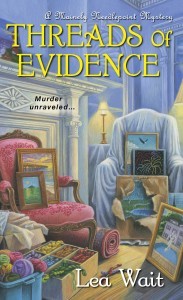
Twisted Threads, the first in the series, got some great reviews and I was pleased with sales. So far pre-orders of Threads of Evidence look good; pre-publication reviews have been great. But until the final numbers are in, an author (and her publisher) don’t really know how many readers a new book will find.
And no matter reviews, sales determine whether a series will continue. I’ve been lucky: based on sales for Twisted Threads and the manuscripts of the first three books in the Mainely Needlepoint series, my publisher has contracted for six books in the series. By the time I’ve completed those six manuscripts, readers’ verdicts on the series will be in. Sales numbers will determine whether Angie Curtis and her friends in Haven Harbor, Maine, will continue solving crimes.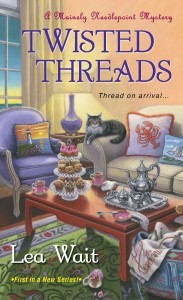
In the meantime, I’ve spent the summer writing the 8th in the Shadows Antique Print mystery series (which won’t be published until September of 2016). The 4th in the Mainely Needlepoint series is due to my editor December 1. So, no. I’m not bored.
Every time I begin a new book I’m excited about the characters and plot I’m putting together. In Threads of Evidence, I combined some of the elements I love in books I choose to read myself: an old, deserted, Victorian house, full of old furniture, art and needlepoint. A mysterious death in the past that is shadowing people today. A small harbor town in Maine with a working waterfront. Neighbors who’ve known each other, and each other’s families, for generations … but may or may not know all their secrets. A few plot twists and turns and surprises.
I’m hoping my readers will enjoy coming with me on that journey.
So — my fingers and toes are crossed. I’ll be sending out notes and postcards to readers on my mailing list. I’ve already written a couple of dozen guest blogs about Threads of Evidence, hoping to reach new readers. My website is updated. (There’s a link to a prequel of Threads of Evidence there.)
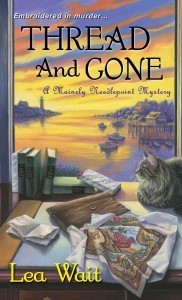 But, after that, like a child who leaves home to seek his or her fortune, Threads of Evidence will be on its own. I hope it finds many friends in many places.
But, after that, like a child who leaves home to seek his or her fortune, Threads of Evidence will be on its own. I hope it finds many friends in many places.
In the meantime, I’ll be starting to prepare promotion for Thread and Gone, the next in the series, which will be published at the end of December. And writing Dangling By a Thread, the book after that.
And wishing Threads of Evidence well in its journey.
August 18, 2015
The Common Herd
Dorothy Cannell: Several years ago I was invited to a drinks and ‘horseydervy” party  where other than my husband and hostess I didn’t know anyone present. As a result, the latter took me round the room and made introductions. Husband, true to form, merged into a group of men talking about tools and their reverence for Home Depot. During my circling I heard several people say how wonderful it was that – let’s call her ‘Estelle’ – had come. Such a surprise! So rarely did she socialize. Couldn’t afford to take time away from her life’s work.
where other than my husband and hostess I didn’t know anyone present. As a result, the latter took me round the room and made introductions. Husband, true to form, merged into a group of men talking about tools and their reverence for Home Depot. During my circling I heard several people say how wonderful it was that – let’s call her ‘Estelle’ – had come. Such a surprise! So rarely did she socialize. Couldn’t afford to take time away from her life’s work.
 Glances were cast in the direction of woman standing in a corner. I won’t describe her other than to say she was approximately my age and she had that clever way with floaty scarves that I have never managed. I was intrigued and a little intimidated when my hostess brought me up to her. What could this life’s work be? Something scientific, or math related perhaps. Having never grasped how electricity works and having long forgotten how to do fractions, I have always thought people of that turn of mind brilliant beyond belief. It was a shock when my hostess announced after making the introduction that Estelle and I had something in common.
Glances were cast in the direction of woman standing in a corner. I won’t describe her other than to say she was approximately my age and she had that clever way with floaty scarves that I have never managed. I was intrigued and a little intimidated when my hostess brought me up to her. What could this life’s work be? Something scientific, or math related perhaps. Having never grasped how electricity works and having long forgotten how to do fractions, I have always thought people of that turn of mind brilliant beyond belief. It was a shock when my hostess announced after making the introduction that Estelle and I had something in common.
“You both write.”
“Oh! So nice to meet you!” I said on a gulp of relief. This did make things easier. “I’m sorry I didn’t catch your last name. What’s your area?”
“Literary.”
“Dorothy does mysteries,” contributed our hostess.
“Really?” Estelle stared over my head as befitted someone on a higher plane. Understandable, of course! After all … genre fiction! The fact that people read it by the droves only proves how tacky it must be.
“I’m afraid I haven’t heard of you,” she continued, “but then I wouldn‘t have even if you were a name. I haven’t read a novel in years, even of the critically acclaimed sort. I can’t allow another’s prose to cloud my own, to infect my vision … the luminosity that must pervade not only every sentence but every word.”
“Estelle has been working for years on this book,” beamed our hostess, “so it is bound to be incredibly significant when finished and will win all the coveted awards. The Pulitzer, the Booker …”
“I’d rather not say anymore about it,” said Estelle, meeting my eyes for the first time. “I don’t want to sound rude, but I get tired of fending off questions about the concept – I suppose you’d call it the plot.” She could have been speaking to a toad.
I didn’t ask if it was her first. Had to be if it’s her life’s work. I caught sight of my husband  and murmured that I’d better join him before he bored people talking about the fence he was building to keep in the dog. He can go on a bit about ‘Do it yourself’ challenges, but I was suddenly eager to have him enchant me with a monologue on hammers. They make such lovely murder weapons. Everyone has one, so hard to identify if you get the blood off right away. I wondered, as I sped his way, how many people had been tempted to give Estelle a mortal clout to the head. This summer I have thought several times of that encounter with her and I have to say that her isolating herself in her ivory tower, far from the common herd, has grown in appeal.
and murmured that I’d better join him before he bored people talking about the fence he was building to keep in the dog. He can go on a bit about ‘Do it yourself’ challenges, but I was suddenly eager to have him enchant me with a monologue on hammers. They make such lovely murder weapons. Everyone has one, so hard to identify if you get the blood off right away. I wondered, as I sped his way, how many people had been tempted to give Estelle a mortal clout to the head. This summer I have thought several times of that encounter with her and I have to say that her isolating herself in her ivory tower, far from the common herd, has grown in appeal.
I’d be much further ahead with Peril in the Parish if not having spent a lot of time with family and friends, either at home or on excursions around Maine. Perhaps if I’d proclaimed that I was writing a significant book, one certain to set the literary world ablaze – that would have Austen, Dickens and Tolstoy turning in their graves in envy, they would have insisted on my having months … years of alone time with my masterpiece. I do hope Estelle’s was not destined to languish in a drawer until it turned to dust and that she has not come to regret not mingling more with the common herd.
I’ve found there’s a lot of grazing to be done – helpful to propelling my storyline forward when living life at its most wonderfully interrupted.
Dorothy




